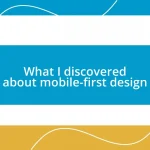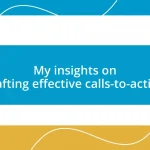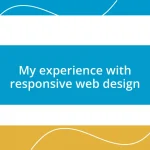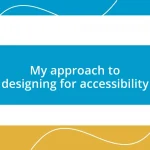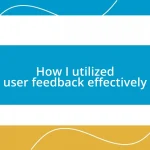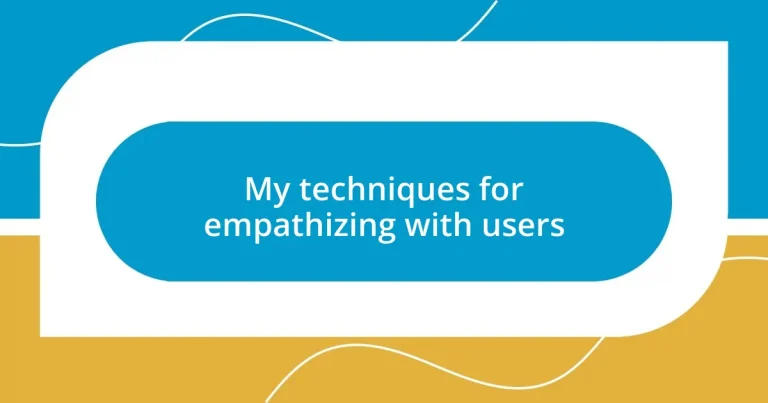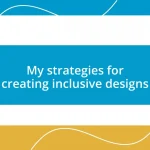Key takeaways:
- Understanding user needs requires active listening and stepping into their shoes to gain insights beyond surveys.
- Building emotional connections with users enhances loyalty and emphasizes the importance of joyful experiences in design.
- Asking open-ended questions encourages storytelling, revealing deep emotions and valuable user experiences.
- Implementing changes based on user feedback can significantly improve product usability and foster team collaboration for innovative solutions.
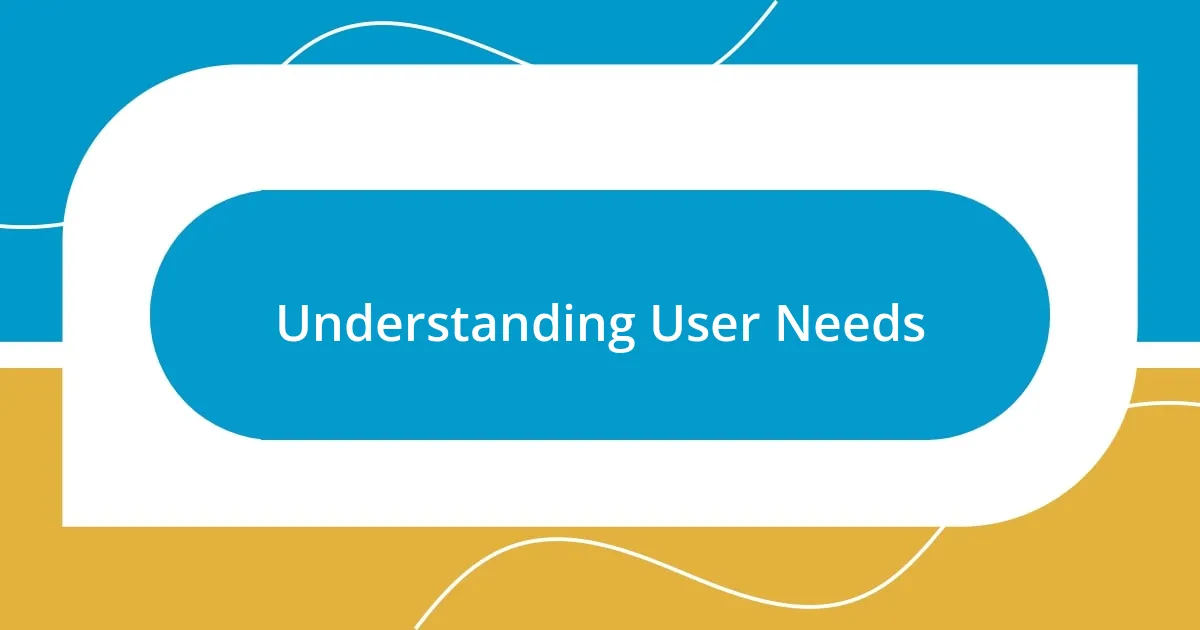
Understanding User Needs
Understanding user needs is a journey that requires active listening. I remember a time when I conducted user interviews for a project. One particular conversation left a lasting impression on me; a user shared their frustrations about features they felt were designed without their input. This moment highlighted how crucial it is to genuinely hear users’ concerns and show empathy towards their experiences.
I often find myself reflecting on how easy it is to assume we know what users want. Have you ever had a brilliant idea that crumbled when tested in the real world? I definitely have. I realized that by stepping into the users’ shoes and observing their interactions firsthand, I could uncover insights that surveys and data alone often overlook. Engaging with users in their environment has allowed me to understand not just what they need, but also why they need it.
In my experience, emotions play a significant role in user needs. I’ve noticed that when users express their challenges, it often stems from deeper feelings of frustration or confusion. By empathizing with these emotions, I can prioritize features that truly matter, ultimately fostering a better connection between users and the product. Isn’t it incredible how a little empathy can transform our approach to design?
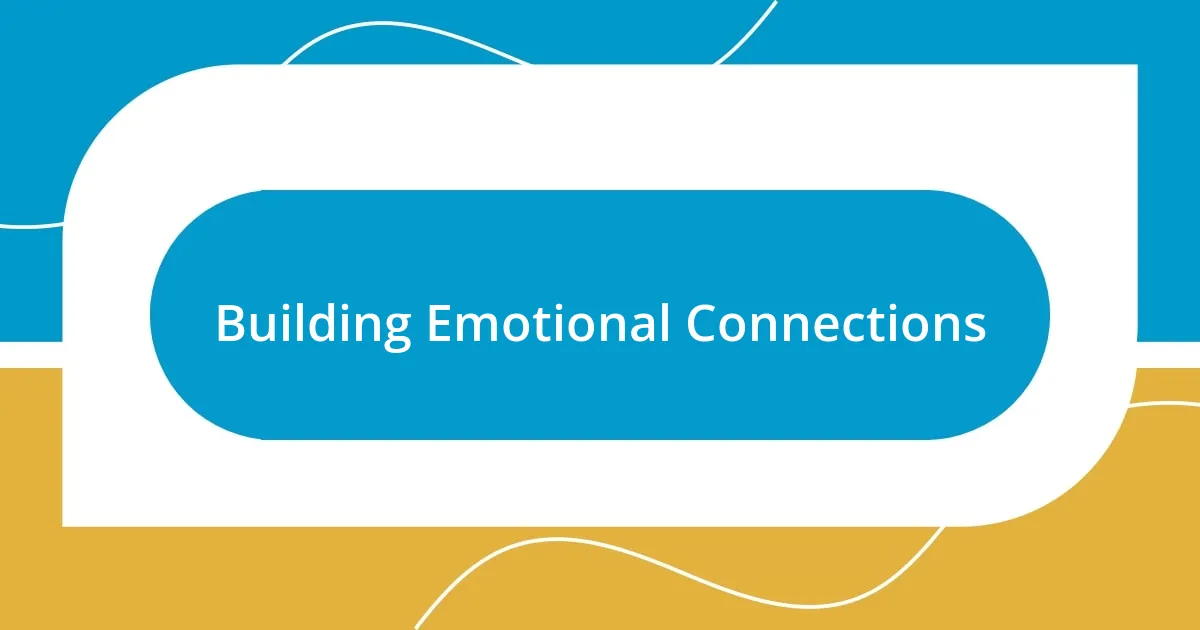
Building Emotional Connections
Building emotional connections with users goes beyond just meeting their needs; it’s about resonating with their feelings. I remember a session where a user spoke about a moment of joy they experienced while using a feature—it really struck me. That shared emotion not only inspired me to enhance that feature but also reinforced the importance of creating joyful experiences. Connecting emotionally allows users to feel seen and valued, which leads to deeper loyalty.
When striving to build these emotional connections, consider:
- Active Listening: Genuine listening opens the door to understanding users’ true feelings and experiences.
- Personal Stories: Share anecdotes that reflect user experiences; it makes the interaction relatable.
- Visual Cues: Pay attention to body language during conversations; it often tells a different story than words alone.
- Follow-Up: Reaching out after a discussion shows users that their thoughts are valued and helps strengthen ties.
- Celebrate Milestones: Recognize achievements and progress within the user journey to cultivate a sense of partnership.
By integrating these elements, I find that the emotional ties we cultivate can significantly enhance user experiences.
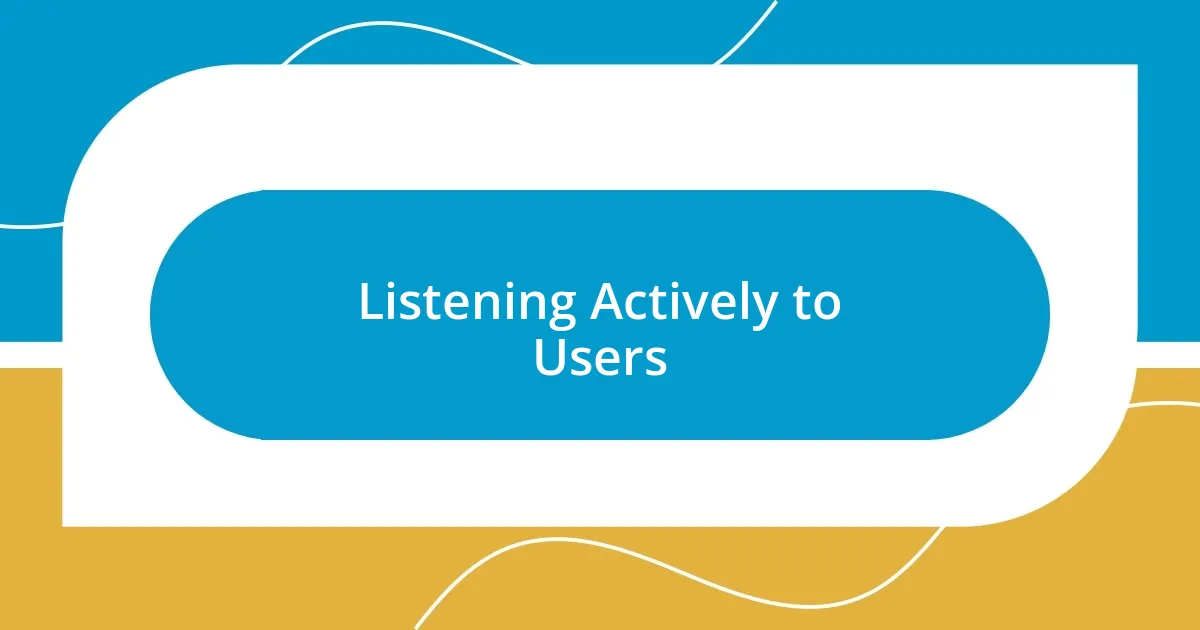
Listening Actively to Users
Listening actively to users is the bedrock of understanding their needs. I once had a user who paused mid-sentence, clearly grappling with a point they wanted to express. Instead of filling the silence, I waited. That moment of patience allowed them to articulate a concern buried deep in their experience, reminding me how critical it is to create a safe space where users feel encouraged to share. Engagement isn’t just about responding; it’s about being fully present and allowing conversations to unfold naturally.
I often utilize follow-up questions to deepen my understanding during conversations. One memorable instance involved a user discussing their challenges with a specific tool. By asking, “Can you tell me more about why that feature feels limiting?” their frustration transformed into valuable insights about potential improvements. This approach not only clarifies their thoughts but also shows them that I genuinely value their input. It’s fascinating how one thoughtful question can open up new avenues for discussion.
What I’ve learned over time is that active listening can transform user interactions. During a workshop, I invited participants to share their experiences using our platform. Not only did they narrate their journeys, but there were moments of laughter, surprise, and even sadness. Each emotion they expressed provided a deeper understanding of their relationship with the product. This connection didn’t just inform my improvements; it made me passionate about enhancing the user experience moving forward.
| Listening Techniques | Description |
|---|---|
| Reflective Listening | Repeating back what users say to unify and validate their feelings. |
| Paraphrasing | Summarizing user thoughts to ensure clarity and comprehension. |
| Open-Ended Questions | Encouraging users to elaborate beyond simple yes or no answers. |
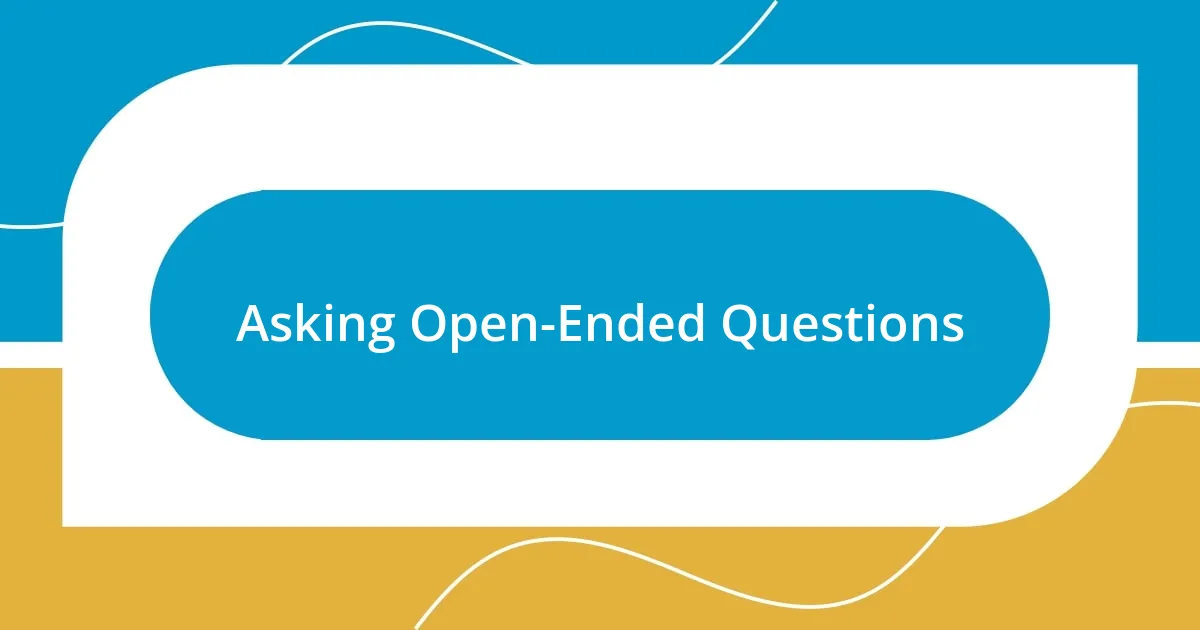
Asking Open-Ended Questions
When I ask open-ended questions, I often find that the conversation takes unexpected and enriching turns. For instance, during a focus group, I posed the question, “What was your first impression when you started using this app?” The responses were varied, revealing not just usability issues but also deep emotions tied to their initial experiences—some users even shared stories of feeling overwhelmed yet excited. It struck me how a simple invitation to reflect opened a door to their personal journeys, providing insights that I never anticipated.
I believe the beauty of open-ended questions lies in their ability to encourage storytelling. I remember a feedback session where I asked, “Can you describe a particular moment when our product really helped you?” One user shared a heartfelt moment when the app assisted them during a family emergency. Hearing that narrative wasn’t just about understanding the functionality; it highlighted the human connection that our product facilitated. It reinforced for me how deeply intertwined our technology can be with life’s pivotal moments.
Reflecting on this, I can’t help but wonder: how often do we miss opportunities for connection by sticking to close-ended questions? I’ve learned that when users are given the space to express themselves, their insights lead not just to product improvements but also to a shared sense of value and understanding. Every time I engage in this way, I come away with a renewed appreciation for the role empathy plays in design.
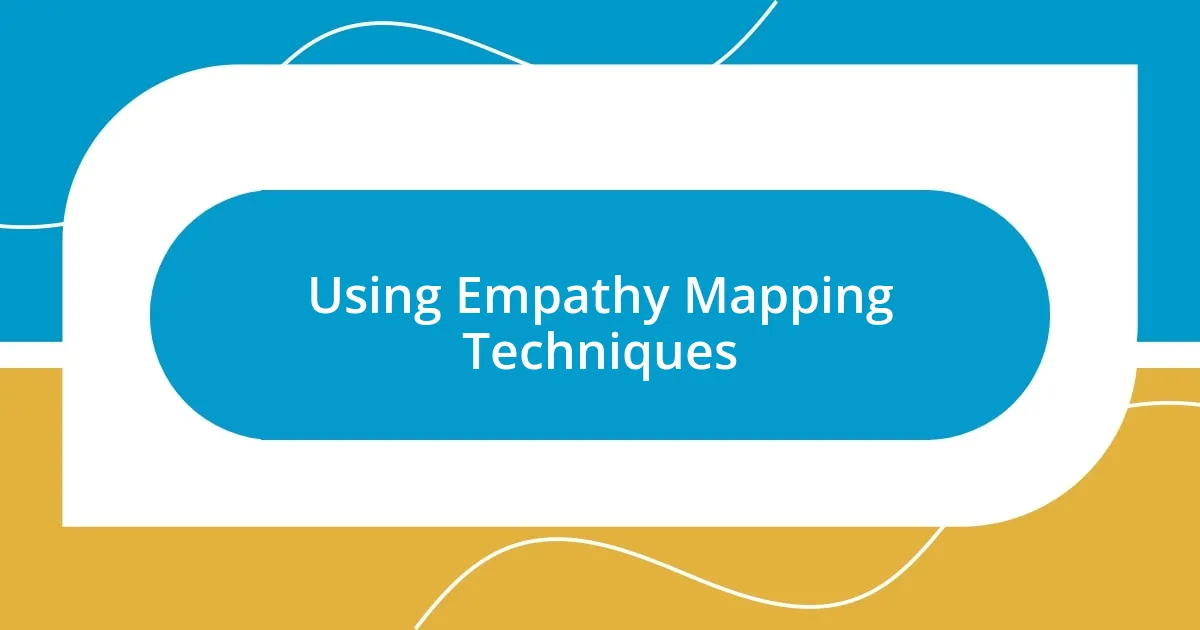
Using Empathy Mapping Techniques
Using empathy mapping techniques has become a cornerstone of my approach to understanding users. I once facilitated a workshop focused on empathy mapping, where participants created visual representations of their ideal users. As we pieced together the layers of user emotions, thoughts, and behaviors, I was surprised by how revealing the process was. It dawned on me that this method not only helps to identify user pain points but also fosters a deeper emotional connection with the data we collect.
Empathy mapping isn’t just a task; it can be a transformative experience. During one session, I watched a team realize that their assumptions about users didn’t align with the real experiences shared during mapping. Suddenly, they were seeing their users not as numbers or words on paper but as real people with fears and aspirations. It left me wondering, have we been too focused on metrics instead of truly understanding our audience? This exercise illustrates how empathy mapping can spark meaningful conversations that lead to innovative solutions grounded in real user needs.
What I love most about empathy mapping is how it creates a shared understanding in a team. In my experience, when everyone contributes their insights into the map, it often leads to heated discussions about user motivations, which is exhilarating. I remember a moment when a colleague passionately argued that a certain feature redesign could significantly impact users’ emotional well-being. That’s the beauty of this technique; it allows for a collaborative environment where the importance of empathy becomes the underlying foundation for product decisions. It leaves me with a question: how often do we pause to map our users’ experiences before jumping to solutions?
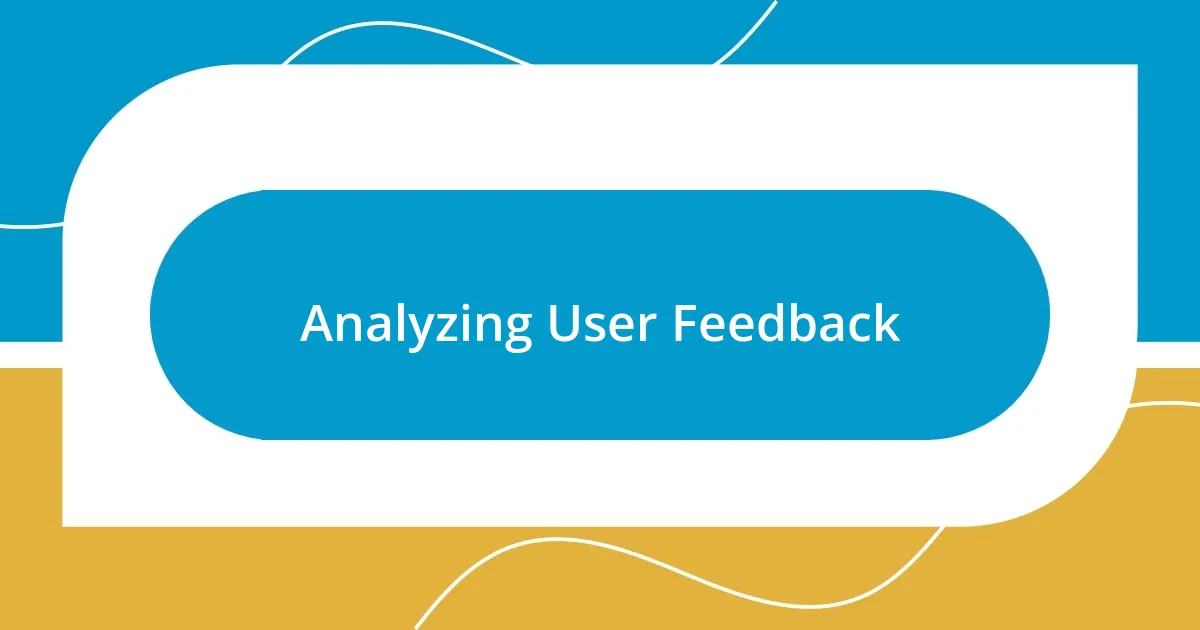
Analyzing User Feedback
Analyzing user feedback is an eye-opening experience that can truly shift your perspective on your product. I once gathered feedback from users who described their struggles with a specific feature, and it hit me how often we overlook their daily challenges. I recall one user vividly explaining how a confusing interface added stress to her already hectic routine. Hearing her frustration made me rethink not just the design but the entire user journey. Isn’t it fascinating how authentic narratives can illuminate paths for improvement?
There was a moment during a feedback session when one participant spoke about a pain point that we hadn’t prioritized. His story resonated deeply with everyone in the room, and it was almost like a lightbulb went off. This real-time analysis of emotion and context left us all pondering: how can we ensure that user voices aren’t just heard but genuinely felt within our design processes? It’s moments like these that reinforce my belief in analyzing feedback not just for data, but for the rich, emotional stories that can guide our next steps.
As I sift through comments and ratings, I always challenge myself to go beyond the numbers. It can be easy to get lost in the metrics, but I find that the true value lies in the heart of the user experience. When I read a heartfelt review, it strikes a chord, reminding me that behind every piece of feedback is a human being sharing their reality. Have we been taking enough time to immerse ourselves in these stories? For me, that’s where the real transformation begins—embracing empathy in our analysis to create products that truly resonate with users.
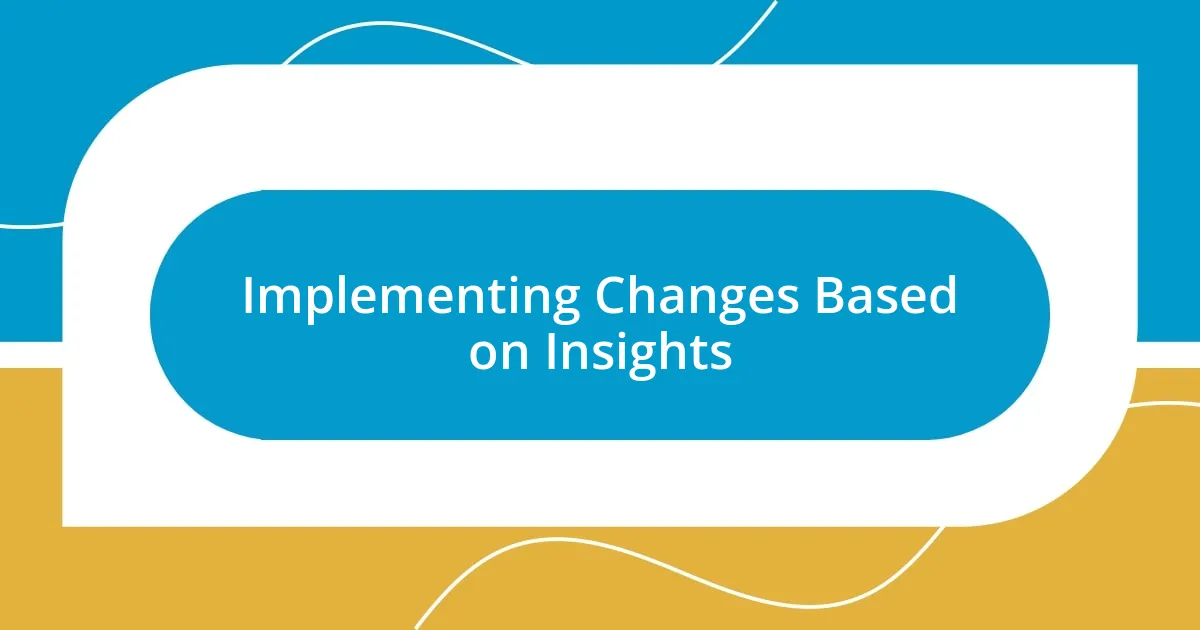
Implementing Changes Based on Insights
Implementing changes based on insights is where the rubber truly meets the road. I recall a project where user feedback revealed that our onboarding process felt overwhelming. After digesting that information, we made it a priority to simplify the steps. It was incredible to witness how tweaking just a few elements led to a significant drop in drop-off rates. I think to myself, how often do teams overlook such straightforward fixes in pursuit of bigger changes?
It’s essential for me to foster an environment where feedback translates into action. I learned this while working on a collaborative project, where we held a brainstorming session specifically to unpack user insights. The atmosphere was electric as team members shared ideas inspired by compelling user stories. I felt the excitement build when a junior team member proposed a solution that transformed a major user pain point. Isn’t it powerful when fresh perspectives can lead to meaningful changes?
I’ve also found that involving users in the design process can be invaluable. For instance, we once engaged a small group of users in a co-creation workshop, where they helped us redesign a feature. The insights shared during that session were nothing short of transformative. Watching users become active participants in shaping the product sparked a new level of enthusiasm within our team. It made me wonder, how can we keep these conversations ongoing to ensure our products evolve with our users’ needs?


